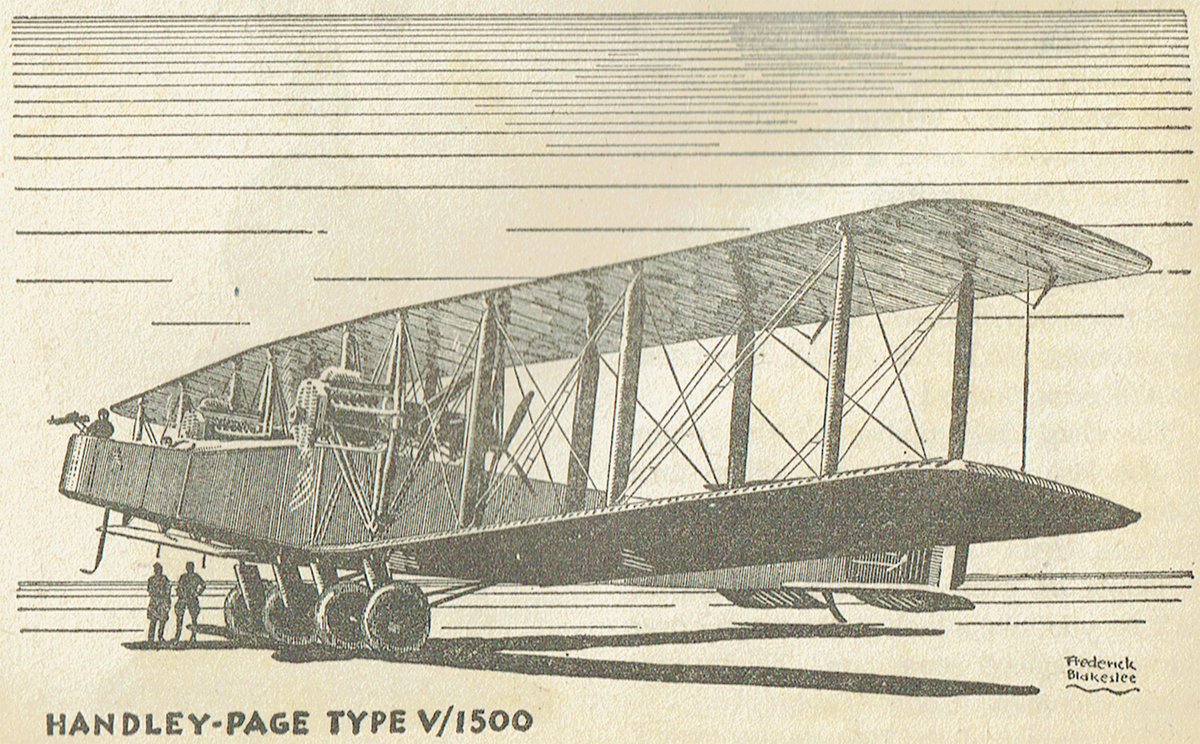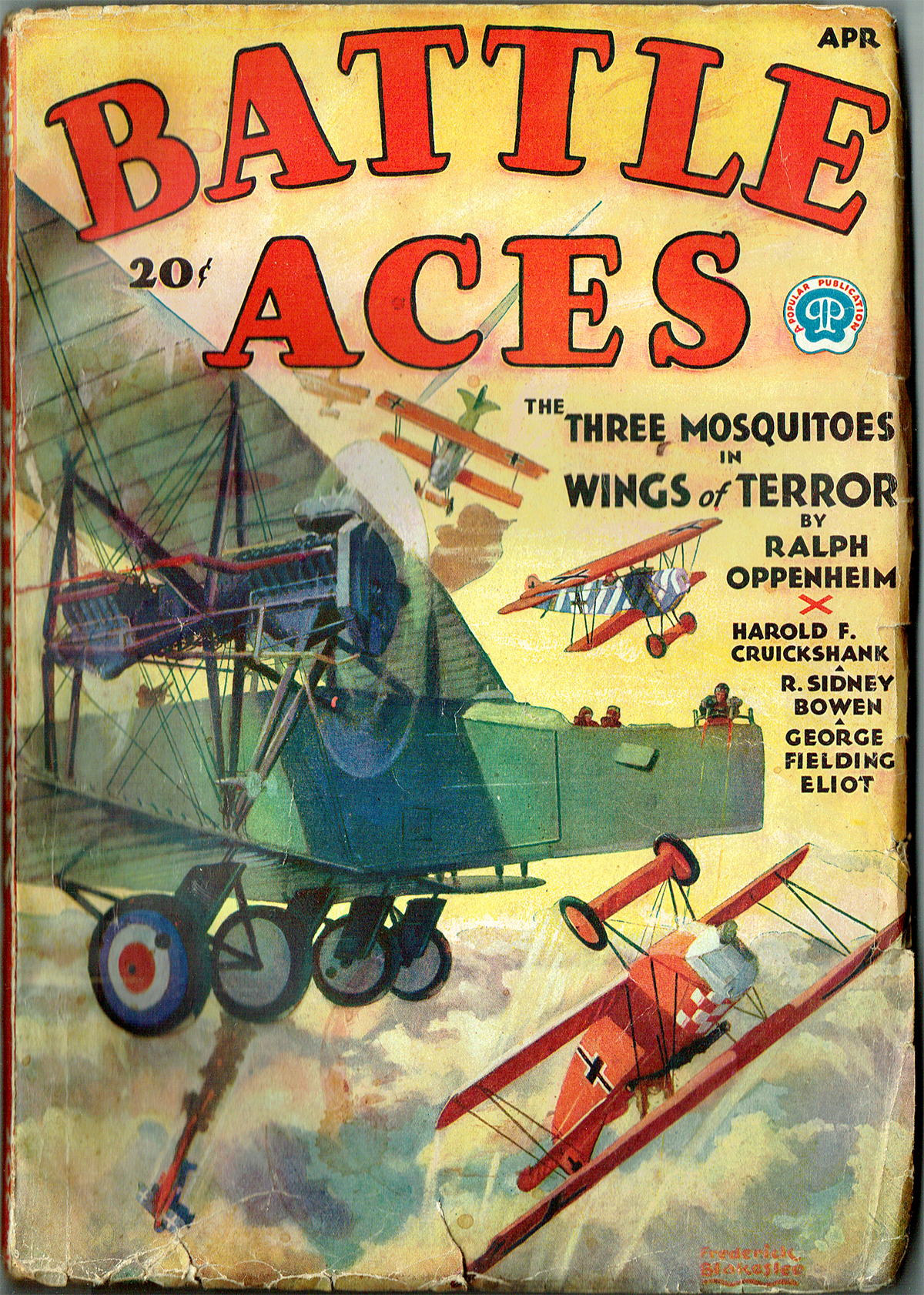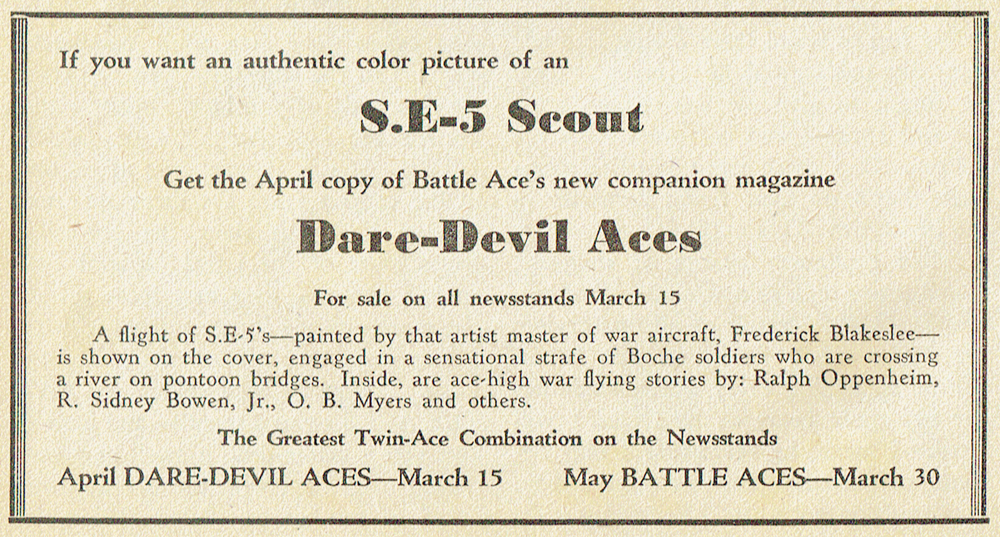“Handley-Page Bomber” by Frederick Blakeslee
Editor’s Note: This month’s cover is the eleventh of the actual war-combat pictures which Mr. Blakeslee, well-known artist and authority on aircraft, is painting exclusively for BATTLE ACES. The series was started to give our readers authentic pictures of war planes in color. It also enables yon to follow famous airmen on many of their amazing adventures and feel the same thrills of battle they felt. Be sure to save these covers if you want your collection of this fine series to be complete.
 THE COVER this month shows a Handley-Page bomber being attacked by a flock of Fokkers. The true story behind this daring scene was related to me by the hero of the incident, a former R.A.F. flyer, who was flying one of the first bombers of this make to appear at the Front.
THE COVER this month shows a Handley-Page bomber being attacked by a flock of Fokkers. The true story behind this daring scene was related to me by the hero of the incident, a former R.A.F. flyer, who was flying one of the first bombers of this make to appear at the Front.
The pilot—who wishes his name withheld—was returning from a mission over Germany about ten o’clock in the morning. He was several kilometers the wrong-side of the lines and flying as high as possible above a sea of clouds, when he noticed some specks approaching from the left. They rapidly overtook him and proved to be a flight of five gaily painted Fokkers. For a time the Fokkers flew alongside but out of range of theliandley, while they looked it over, for this was the first ship of the type they had seen. The lone Handley continued on its way, with its gunners on the alert. When it neared the lines and it appeared that their prize was to escape unmolested, the Boches decided to chance an attack.
They made the mistake of closing together instead of separating and coming in from five different directions. As they approached, the rear gunner let go in their general direction, more to warm his gun than with any thought of doing damage. Much to everyone’s surprise a Fokker, painted all blue, turned on its back and dove for the ground in flames.
Only one of the staffel appeared to be at all experienced. He flew a bright red ship and at first the men in the Handley thought he might be Richthofen. This Fokker dove and zoomed with terrific speed. After several exciting attacks, at last he came so close at such a fast pace that he was unable to stall underneath, so started a loop. He came out from under the Handley on his back very near to the bow of the big ship. The front gunner, quick to grab the opportunity, poured a hot fire of blazing tracers into the enemy at close range. The Fokker completed its loop, but instead of recovering, plunged down, whirling through the clouds at a tremendous speed. The others, disheartened, turned about and sped toward Germany. A short while later the Handley-Page landed at its airdrome unharmed.

The machine pictured is the four-engined type V/1500. It was developed from the two-engined Handley-Page and was used principally for night bombing. Its most spectacular mission was to have been the bombing of Berlin—a mission which was only forestalled by the signing of the Armistice.
The fuselage is the same as in the two-engined ship (0/400). The four engines are carried two tandemwise on either side of the fuselage. They are not enclosed in any cowling. The upper and lower main planes are of equal span, the upper plane being flat and the lower having a dihedral.
Big as these ships were, they were smaller than a giant German Zeppelin bomber. The span was 126 feet—8 feet shorter than the Zeppelin. The overall length was 62 feet—10 feet shorter than the Zeppelin. Empty, it weighed 15,000 lbs. It could stay aloft fourteen hours carrying 1,000 gallons of gas. Its speed was 103 miles per hour at a low altitude and 95 miles per hour at 10,000 feet. Its landing speed was 50 miles per hour. It could climb to 10,000 feet in twenty-one minutes. Loaded it weighed 30,000 lbs. The power plant had four 375 horse power Rolls Royce “Eagle” VIII engines.

“Handley-Page Bomber” by Frederick M. Blakeslee (April 1932)





